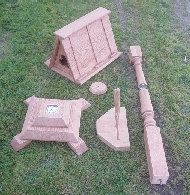March 25, 2008 - If you've read my other project writeup on the 15th C. benches, then you are well aware of our plot to take over the world. This was a part of it. =) I did some research into 15th C. lecterns and/or music stands that I might be able to duplicate, and I found a load of evidence. So, I had no choice but to proceed!
I was able to find little documentation for individual music stands in the modern form that we think of until the very early 17th Century. Most of the time, singers seem to have gathered around a large book set on a huge lectern, or they had part books in the later 16th C. For my purposes, a music stand must be reasonably transportable. However, there is extant icongraphy in which people have been reading from standing lecterns, and this is what my work was based upon. The goal was to produce a period stand in which one could play both standing up and sitting down, for maximum flexibility. I briefly investigated the use of stands that were placed on a table, but then realized that with a little ingenuity, I might be able to turn a standing lectern into one that could also be placed on a table, if desired.

Studiolo from the Ducal Palace in Gubbio (detail), 15th century (ca. 1479-82)
Designed by Francesco di Giorgio Martini (Italian, 1439-1502); Executed by Giuliano da Majano (Italian, 1432-1490), Made in Gubbio, Italy
|

RA10 (13a) Ranworth (Norfolk), Church of St. Helen, lectern. Presumably dated from the late 15th century
|

Master of Heiligenkreuz
Annunciation
c. 1410
|

1428, Citation missing (sorry!).
|

BALDOVINETTI, Alessio
Annunciation
1447
|

MAINARDI, Bastiano
Annunciation (detail)
1482.
|

PINTURICCHIO
Annunciation (detail)
1501
|
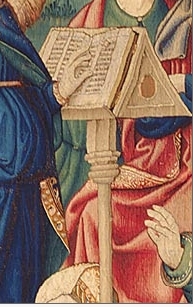
"The Triumph of Fame" from a set of The Triumphs of Petrarch, ca. 1502-1504
|
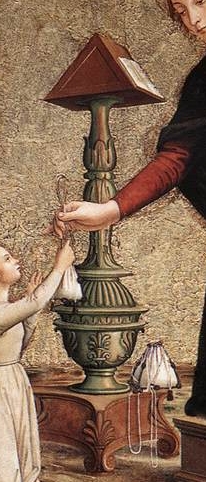
ANTONIAZZO ROMANO
Annunciation (detail)
1485
|
As one can observe through both extant and iconographic evidence from the early 15th century to at least the late 15th century, this particular triangular style lectern was common in Flemish, Italian, and German artwork. The three sided polygon, with its obvious implications to the trinity, was widely used for this purpose. Figure 3 is also of interest which shows a "staggered" lectern, in which one would read from a height to others below, the purpose of which is unclear.
Updated on Aug 28, 2015: I had to add a picture of this particular lectern which seems like it could have been made to be "adjustable" by spinning the lectern itself. Of course, this could simply have been an artistic design, but the theory is at least plausible and possible with the tools and techniques available to the craftspeople at the time. Image from the manuscript The Hague, RMMW, 10 A 11. Augustine, La Cite de Dieu (Vol. I). Paris, Maitre Francois (illuminator); c. 1475; 1478-1480
|

|
Over half of the images above show some kind of decorative hole in the side of the lectern, a trait I duplicated in my version. Of those with holes, some are round, and some are "mousehole" shaped, but one from the Master of Heiligenkreuz is a trifoil design, which I chose to emulate.
The base material used was red oak, finished with a golden oak water based stain. I chiefly used elements from the Mainardi and Heiligenkreuz paintings to craft my version. The Mainardo has a horizontal piece across the top which I deemed very useful for carrying in a deconstructed form as well as some ulterior motives which you will soon discover. =) The Heiligenkreuz, as mentioned, has a delightful trefoil design, which I also adapted in the sides of my lectern. I also looked to the "The Triumph of Fame" for a simple design for the standing support and the intarsia in the Studiolo for the base. The standing support was a hemlock banister support (chosen as a compromise between cost and look), and the base was crafted of 1 5/8" thick red oak. Note that most of the lecterns are built into a table of some sort, clearly not designed to be moved frequently. Screws, covered by oak plugs, were used in most aspects of construction.
|
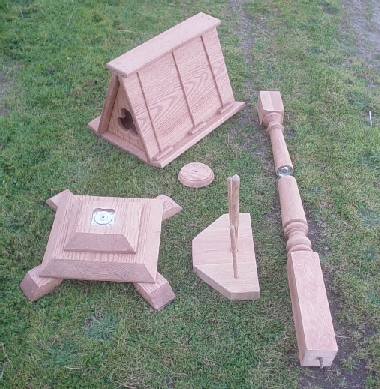
|
From this point on, I had to factor in compromises for our purposes. The lectern, stand, and base were made in three individual pieces, all of which were connected by means of threaded rods and receivers. As a result, not only can the unit be dismantled, but the lectern itself can be placed on a table for use if desired. The hemlock banister was cut into two pieces, and a threaded rod and receiver installed between the two pieces to allow one to play either at a standing height or a seated height. This allows the player flexibility and eliminates the need to carry around another support should they wish to play seated. The round disc is a spacer to be used when playing seated; otherwise the threaded rod is too long, and will not seat completely in the lectern itself.
|
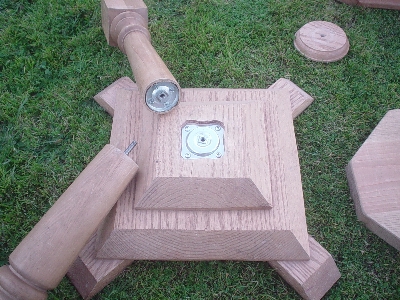
|
Often times, playing music outdoors has interesting side effects to reckon with, specifically wind. I crafted some unique devices which "locked" into the lectern to hold the pages down in case of winds. I cannot document this, but it is an elegant solution to a common problem. One inserts the angled end under the top of the stand, and then lays the bottom into the ridge where the paper sits. Because of the angle, the holder cannot fall out.
|
 
|
Light is often an issue when playing in the evening, so high intensity LEDs were installed into the underside of the horizontal support of the lectern. The LEDs are placed on both sides, and are controlled independently via a rotary potentiometer installed on the inner side of the lectern. By reaching in the side of the lectern, one can adjust either side's brightness, allowing a player on each side of the lectern to govern their illumination independently. The potentiometers are slightly visible from the other side, but it requires one to actively look inside the dark interior of the lectern. The LEDs are powered by 3 C batteries, which are cleverly (again) hidden in a channel inside the lectern at the top. One side of the lectern can be removed to allow the player to replace the batteries as they wear out. By placing two candles or similar lighting devices on top of the lectern, the look of candlelight can be achieved without sacrificing authenticity. Unfortunately, I am unable to document neither the page locks nor the lighting (at least not until the 17th century, as stated earlier), however they are both rather unobtrusive and do not detract from the piece.
|

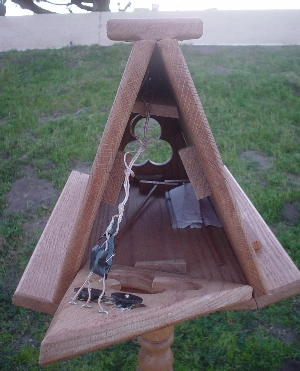
|
Finally, a writeup like this would not be complete without a picture to show it in use, and here a group of musicians (myself included) are playing at the Castello di Amorosa for their 2010 Midsummer Tournament in the Il Passito room. If you look closely, you will see the odd thing with those three rods sticking out of it - you guessed correctly, those are for holding instruments (although I have not done any research on instrument stands, it seems a plausible solution).
You will also notice that the top of the stand works passing well as a place to rest one's wine glass, and from time to time, a small creature can decide that the interior of the lectern makes an excellent spot to observe and listen to music. =) Additionally, you can also see my prototype music stand which was done in pine closest to you. I decided to go with oak for the "burly" look and because it wears like iron!
|
 (c) Sarah Goodman
(c) Sarah Goodman
|

















